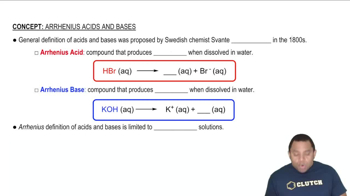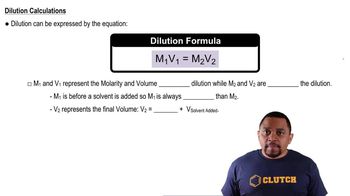Here are the essential concepts you must grasp in order to answer the question correctly.
Acid-Base Chemistry
Acid-base chemistry involves the study of acids, bases, and their reactions. Acids are substances that donate protons (H+) in solution, while bases accept protons. The strength of an acid is often measured by its dissociation constant (Ka), which indicates how completely it ionizes in water. Understanding these principles is essential for calculating pH and determining the behavior of hydrofluoric acid (HF) in solution.
Recommended video:
Arrhenius Acids and Bases
pH Scale
The pH scale quantifies the acidity or basicity of a solution, ranging from 0 to 14. A pH of 7 is neutral, while values below 7 indicate acidic solutions and values above 7 indicate basic solutions. The pH is calculated using the formula pH = -log[H+], where [H+] is the concentration of hydrogen ions in the solution. This concept is crucial for determining the pH of the hydrofluoric acid solution formed from the HF gas.
Recommended video:
Dilution and Concentration
Dilution refers to the process of reducing the concentration of a solute in a solution, typically by adding more solvent. The relationship between the initial and final concentrations and volumes can be described by the equation C1V1 = C2V2, where C is concentration and V is volume. In this question, understanding how the concentration of HF changes when it is dissolved in water is vital for calculating the resulting pH of the solution.
Recommended video:





